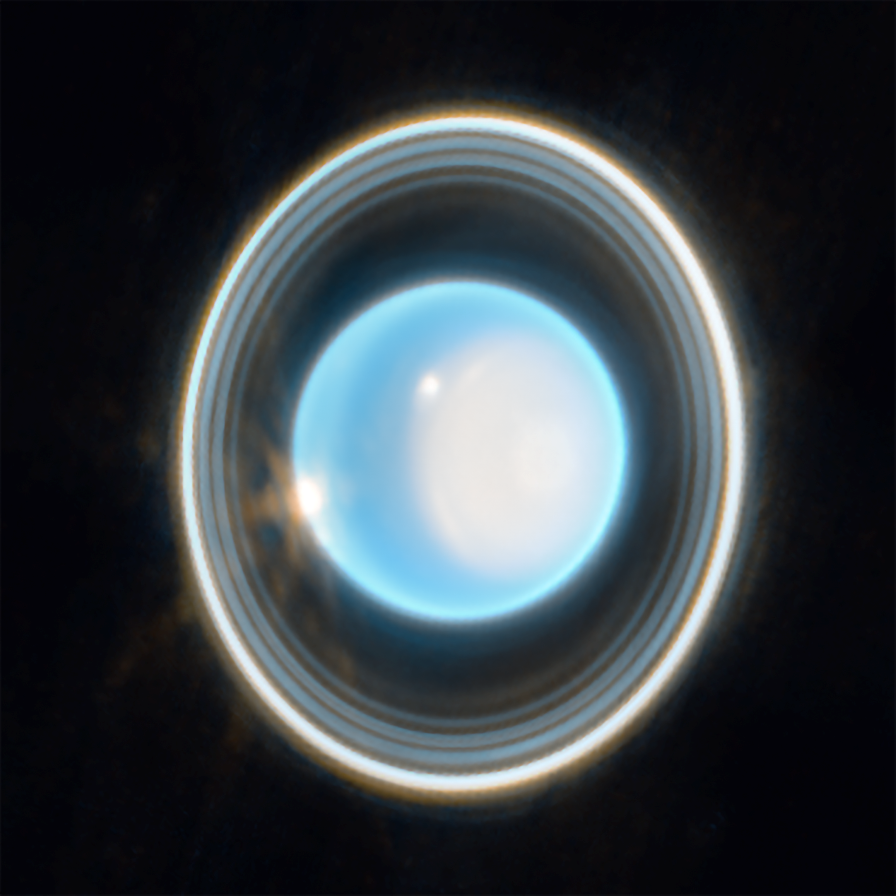November's Night Sky Notes: Spy the Seventh Planet, Uranus
- 10/20/2023
This zoomed-in image of Uranus, captured by Webb’s Near-Infrared Camera (NIRCam) Feb. 6, 2023, reveals stunning views of the planet’s rings. The planet displays a blue hue in this representative-color image, made by combining data from two filters (F140M, F300M) at 1.4 and 3.0 microns, which are shown here as blue and orange, respectively
Credits: NASA, ESA, CSA, STScI. Image processing: J. DePasquale (STScI)
by Liz Kruesi of the Astronomical Society of the Pacific
You might be familiar with Saturn as the solar system’s ringed planet, with its enormous amount of dust and ice bits circling the giant planet. But Uranus, the next planet out from the Sun hosts an impressive ring system as well. The seventh planet was the first discovered telescopically instead of with unaided eyes, and it was astronomer extraordinaire William Herschel who discovered Uranus March 13, 1781. Nearly two centuries passed before an infrared telescope aboard a military cargo aircraft revealed the planet had rings in 1977.
Since that discovery, multiple observatories have revealed more details of Uranus and its ring system. Most recently, the NASA-led JWST space observatory captured the planet and its rings in detail. This recent image combines just 12 minutes of exposure in two filters to reveal 11 of the planet’s 13 rings. Even some of the planet’s atmospheric features are visible in this image. Even with advanced imaging like that from JWST, much of Uranus remains a mystery, including why it orbits the Sun on its side. This is because only one spacecraft has ever visited this planet: NASA’s Voyager 2, which flew by the distant planet in the mid-1980s.
Planetary scientists are hoping to change that soon, though. Scientists recommended in a report released last year from the National Academies of Sciences, Engineering, and Medicine that Uranus be the focus on the next big planetary science spacecraft mission. Such a large-scale mission would gain insight into this icy giant planet and the similar solar system planet, Neptune.

Sky map picturing M45, Uranus and Jupiter, Stellarium
If you want to catch a view of Uranus with your own eyes, now is prime time to view it. This ice giant planet lies perfectly positioned in mid-November, at so-called “opposition,” when its position in its orbit places it on the other side of the Sun from Earth. That location means our star’s light reflects off Uranus’ icy atmosphere, and the planet appears as its brightest.

Sky map picturing M45 and Uranus, Stellarium
To find it, look overhead just after midnight on November 13. Uranus will lie about halfway between the brilliant planet Jupiter and the diffuse glow of the Pleiades star cluster (M45). While Uranus may look like a bright blinking star in the night sky, its blue-green hue gives aways its identity. Binoculars or a telescope will improve the view.
For more about this oddball planet, visit NASA’s Uranus page: https://science.nasa.gov/uranus/facts/
You can find a printer-ready version of this article on our Night Sky Notes resource page every month, free to share with your club newsletter, website, or even local paper!
More Skywatching Resources
Plan your skywatching with help from our planner page, featuring daily stargazing tips courtesy EarthSky monthly sky maps, and videos from NASA/JPL. You can even find out how to spot the International Space Station! Both Astronomy and Sky and Telescope magazines offer regular stargazing guides to readers, both in print and online. Want to join a group of folks for a star party? Find clubs and astronomy events near you, and may you have clear skies!
Last Updated: October 20, 2023

Follow us on Facebook and Instagram for the latest NSN news and outreach photos and subscribe to our YouTube channel for recordings of monthly astronomy webinars and archives of our outreach toolkit demonstration videos. You can also use the hashtags #NightSkyNetwork and #AstronomyOutreach on your social media platforms for a chance to be featured!

Night Sky Network (NSN) member clubs are dedicated to bringing the wonders of space and NASA science to folks across the USA.NSN program participation provides clubs with tools and resources to assist in their public outreach.

The NASA Night Sky Network is managed by the Astronomical Society of the Pacific. The ASP is a 501(c)(3) non-profit organization advancing science literacy through astronomy.
Credits: NASA, ESA, CSA, STScI. Image processing: J. DePasquale (STScI)
by Liz Kruesi of the Astronomical Society of the Pacific
You might be familiar with Saturn as the solar system’s ringed planet, with its enormous amount of dust and ice bits circling the giant planet. But Uranus, the next planet out from the Sun hosts an impressive ring system as well. The seventh planet was the first discovered telescopically instead of with unaided eyes, and it was astronomer extraordinaire William Herschel who discovered Uranus March 13, 1781. Nearly two centuries passed before an infrared telescope aboard a military cargo aircraft revealed the planet had rings in 1977.
Since that discovery, multiple observatories have revealed more details of Uranus and its ring system. Most recently, the NASA-led JWST space observatory captured the planet and its rings in detail. This recent image combines just 12 minutes of exposure in two filters to reveal 11 of the planet’s 13 rings. Even some of the planet’s atmospheric features are visible in this image. Even with advanced imaging like that from JWST, much of Uranus remains a mystery, including why it orbits the Sun on its side. This is because only one spacecraft has ever visited this planet: NASA’s Voyager 2, which flew by the distant planet in the mid-1980s.
Planetary scientists are hoping to change that soon, though. Scientists recommended in a report released last year from the National Academies of Sciences, Engineering, and Medicine that Uranus be the focus on the next big planetary science spacecraft mission. Such a large-scale mission would gain insight into this icy giant planet and the similar solar system planet, Neptune.

Sky map picturing M45, Uranus and Jupiter, Stellarium
If you want to catch a view of Uranus with your own eyes, now is prime time to view it. This ice giant planet lies perfectly positioned in mid-November, at so-called “opposition,” when its position in its orbit places it on the other side of the Sun from Earth. That location means our star’s light reflects off Uranus’ icy atmosphere, and the planet appears as its brightest.

Sky map picturing M45 and Uranus, Stellarium
To find it, look overhead just after midnight on November 13. Uranus will lie about halfway between the brilliant planet Jupiter and the diffuse glow of the Pleiades star cluster (M45). While Uranus may look like a bright blinking star in the night sky, its blue-green hue gives aways its identity. Binoculars or a telescope will improve the view.
For more about this oddball planet, visit NASA’s Uranus page: https://science.nasa.gov/uranus/facts/
You can find a printer-ready version of this article on our Night Sky Notes resource page every month, free to share with your club newsletter, website, or even local paper!
More Skywatching Resources
Plan your skywatching with help from our planner page, featuring daily stargazing tips courtesy EarthSky monthly sky maps, and videos from NASA/JPL. You can even find out how to spot the International Space Station! Both Astronomy and Sky and Telescope magazines offer regular stargazing guides to readers, both in print and online. Want to join a group of folks for a star party? Find clubs and astronomy events near you, and may you have clear skies!
Last Updated: October 20, 2023

Follow us on Facebook and Instagram for the latest NSN news and outreach photos and subscribe to our YouTube channel for recordings of monthly astronomy webinars and archives of our outreach toolkit demonstration videos. You can also use the hashtags #NightSkyNetwork and #AstronomyOutreach on your social media platforms for a chance to be featured!

Night Sky Network (NSN) member clubs are dedicated to bringing the wonders of space and NASA science to folks across the USA.NSN program participation provides clubs with tools and resources to assist in their public outreach.

The NASA Night Sky Network is managed by the Astronomical Society of the Pacific. The ASP is a 501(c)(3) non-profit organization advancing science literacy through astronomy.



